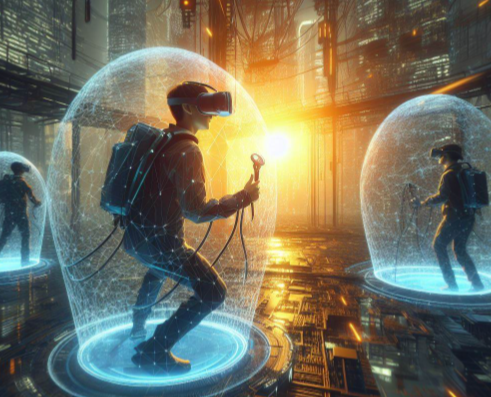Augmented reality (AR) and virtual reality (VR) technologies are transforming the way we interact with digital content and the physical world, offering immersive and interactive experiences across various industries. From entertainment and gaming to education and enterprise, AR and VR applications are reshaping how we learn, work, and play. In this article, we’ll delve into the latest developments in AR and VR technologies and explore their diverse applications and potential impact.

Understanding AR and VR Technologies
Augmented Reality (AR)
AR overlays digital information and virtual objects onto the real-world environment, enhancing our perception of reality and blending digital and physical elements seamlessly. AR experiences can be delivered through smartphone apps, wearable devices, and smart glasses, enabling users to interact with virtual content in real-time.
Virtual Reality (VR)
VR immerses users in a fully digital environment, simulating sensory experiences such as sight, sound, and touch to create a sense of presence and immersion. VR applications typically require specialized hardware, such as VR headsets and motion controllers, to deliver immersive experiences across gaming, entertainment, training, and simulation.
Applications Across Industries
Entertainment and Gaming
AR and VR technologies are revolutionizing the entertainment and gaming industries, offering immersive storytelling experiences, interactive gaming environments, and virtual theme park attractions. From AR-enhanced mobile games to VR-powered immersive experiences, such as virtual concerts and multiplayer gaming experiences, AR and VR are redefining entertainment experiences for audiences worldwide.
Education and Training
AR and VR have significant potential to enhance learning and training experiences by providing immersive and interactive educational content. Virtual classrooms, educational simulations, and immersive training scenarios enable students and professionals to explore complex concepts, engage in hands-on learning activities, and practice real-world skills in a safe and controlled environment.
Recent Developments in AR and VR
Advancements in Hardware
Recent advancements in AR and VR hardware, such as improved display technology, higher-resolution screens, and more ergonomic designs, have enhanced the immersive and comfortable experience for users. Lightweight and wireless VR headsets, such as the Oculus Quest series and HTC Vive Focus, offer untethered freedom of movement and convenience for users.
Content Creation Tools and Platforms
The proliferation of content creation tools and platforms has democratized the creation and distribution of AR and VR content, empowering developers, creators, and businesses to produce immersive experiences. User-friendly authoring tools, such as Unity and Unreal Engine, enable developers to create interactive AR and VR applications with minimal coding experience, while content marketplaces and distribution platforms facilitate the sharing and monetization of AR and VR experiences.
Future Prospects and Challenges
Mainstream Adoption
While AR and VR technologies have gained traction in niche markets such as gaming and entertainment, mainstream adoption remains a challenge due to factors such as cost, accessibility, and content availability. Overcoming barriers to adoption, such as improving affordability, enhancing user experience, and expanding content libraries, will be essential to driving widespread adoption of AR and VR technologies.
Ethical and Social Implications
As AR and VR technologies become more pervasive, ethical and social implications, such as privacy concerns, digital addiction, and virtual harassment, must be addressed to ensure responsible use and mitigate potential harms. Establishing ethical guidelines, privacy standards, and digital well-being practices can help promote safe and responsible use of AR and VR technologies.
Conclusion
AR and VR technologies are poised to revolutionize how we interact with digital content and the physical world, offering immersive and transformative experiences across diverse industries. By leveraging the power of AR and VR, we can unlock new possibilities for entertainment, education, training, and beyond, shaping the future of human-computer interaction and immersive storytelling.